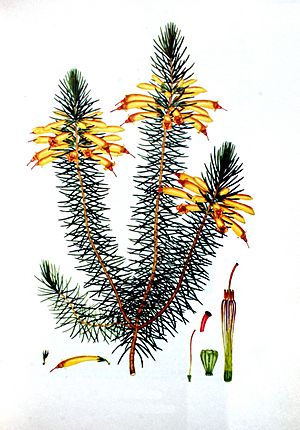Henry Charles Andrews facts for kids
Henry Cranke Andrews (who lived from about 1794 to 1830) was a talented English botanist and artist. He was known for drawing and illustrating plants. For a long time, people thought his middle initial 'C' stood for Charles. But in 2017, his marriage records showed his middle name was actually Cranke! He always signed his work as Henry C. Andrews.
Early Life and Work
Henry lived in a part of London called Knightsbridge. He married the daughter of John Kennedy, who owned a plant nursery in Hammersmith. Mr. Kennedy was a nurseryman, meaning he grew and sold plants. He helped Henry write the descriptions for the many beautiful plants Henry drew.
Henry Andrews was a very special botanical artist. He didn't just draw plants; he also engraved his own pictures onto printing plates. He even added the colors himself and published his own books! This was unusual because most artists at that time only made small drawings for others to publish.
His first big publication was called The Botanist's Repository. It was published in London in ten parts between 1797 and 1812. This book offered beautiful, affordable pictures of plants. It was very popular with the many new amateur gardeners in Britain who loved to grow plants.
His Amazing Plant Art
The famous Kew publication, Curtis's Botanical Magazine, said that Henry Andrews' work was very accurate. This means his drawings were very true to life.
Henry's pictures also had a special artistic touch. They looked more like beautiful paintings compared to the works of other artists. His rivals often focused more on just the scientific details of plants. Henry, however, managed to combine both scientific accuracy with artistic beauty in his illustrations.
See Also
 You can read about Henry Cranke Andrews in Spanish here: Henry Cranke Andrews para niños
You can read about Henry Cranke Andrews in Spanish here: Henry Cranke Andrews para niños


